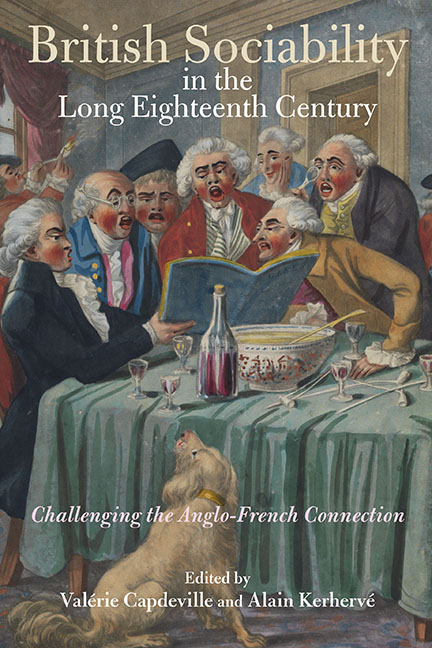Book contents
- Frontmatter
- Contents
- List of illustrations
- List of contributors
- Foreword
- Acknowledgements
- Introduction
- Part 1 Emergence of new political and social practices
- 1 ‘Restoration’ England and the history of sociability
- 2 Mapping sociability on Restoration townscapes
- 3 Club sociability and the emergence of new ‘sociable’ practices
- 4 The tea-table, women and gossip in early eighteenth-century Britain
- Part 2 Competing models of sociability
- Part 3 Paradoxes of British sociability
- Conclusion
- Bibliography
- Index
2 - Mapping sociability on Restoration townscapes
from Part 1 - Emergence of new political and social practices
Published online by Cambridge University Press: 18 September 2019
- Frontmatter
- Contents
- List of illustrations
- List of contributors
- Foreword
- Acknowledgements
- Introduction
- Part 1 Emergence of new political and social practices
- 1 ‘Restoration’ England and the history of sociability
- 2 Mapping sociability on Restoration townscapes
- 3 Club sociability and the emergence of new ‘sociable’ practices
- 4 The tea-table, women and gossip in early eighteenth-century Britain
- Part 2 Competing models of sociability
- Part 3 Paradoxes of British sociability
- Conclusion
- Bibliography
- Index
Summary
THE PRESENT interest in the ‘spatial turn’ might lead us to consider Restoration sociability in the light of the spatial qualities associated with different types of early modern social practices; moreover, recent approaches involving digital imagery might be invoked. Several issues are involved. How did the layout of urban space interact with social structures and with practices of sociability? With respect to representation, how did images of urban places embody that period's view of relations between or within social groups? How did methodologies of visualising social relations evolve at that time? How does science add a new perception of social spaces, both by creating new patterns of sociability and by providing new spatial concepts which can be applied to the visualisation of sociability? How do present-day methods of digital visualisation and spatial representation shed new light on social practices and networks of the past – from ‘maps’ to the present-day notion of ‘mapping’?
The Restoration is known as a period of urban change. The rebuilding of London after the Great Fire was a moment of tension between the several plans proposed for it and the resulting layout. As is well known, each of the options corresponded to a distinct view of urban life, such as Wren's ceremonial plan with grand avenues leading to monuments, Hooke's scientific grid, or the preservation of the existing layout based on properties and the integration of new architecture into the existing urban environment. Thus, plan and reality interact, both at the moment of rebuilding and, retrospectively, in the public imagination, where real buildings are consciously or half-consciously seen against more or less imaginary projects. Urban renewal may be seen at the scale of urban design – architecture in context – which in turn raises the question of the interaction between urban design and society.
The society of the period may itself be viewed in different ways, combining partly inherited appearances of the social structure with new patterns of sociability arising from economic and scientific changes, sometimes clearly visible and sometimes partly guessed only in outline. This is another form of interplay between image and reality.
- Type
- Chapter
- Information
- British Sociability in the Long Eighteenth CenturyChallenging the Anglo-French Connection, pp. 25 - 44Publisher: Boydell & BrewerPrint publication year: 2019



